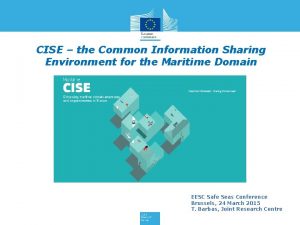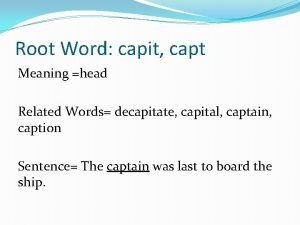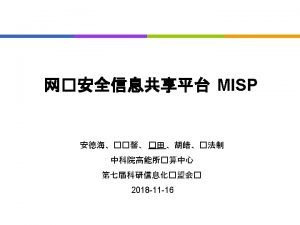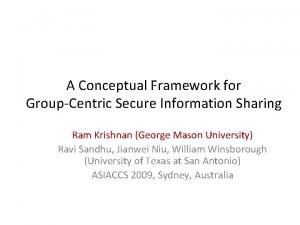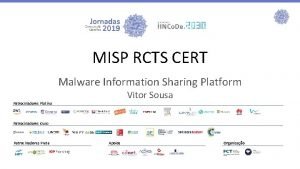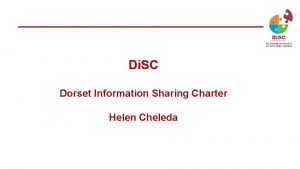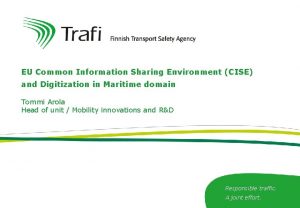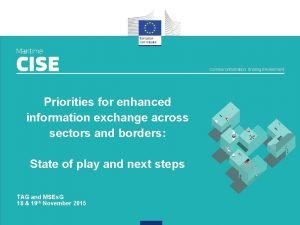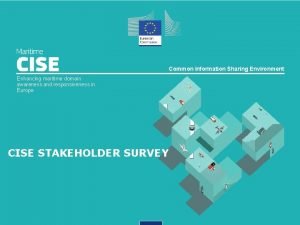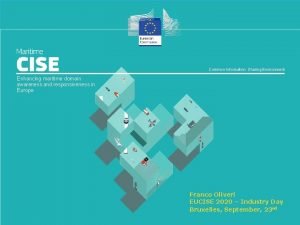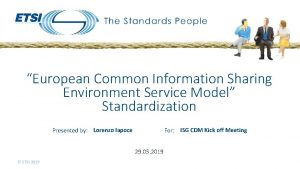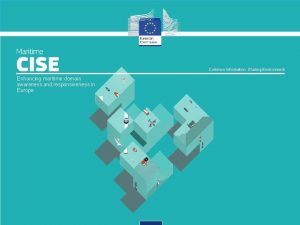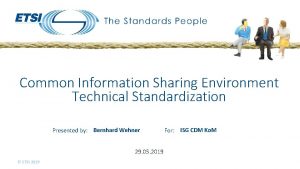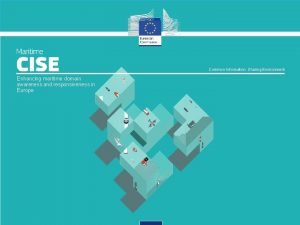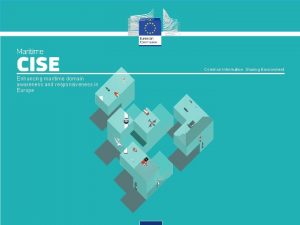CISE the Common Information Sharing Environment for the
















- Slides: 16

CISE – the Common Information Sharing Environment for the Maritime Domain EESC Safe Seas Conference Brussels, 24 March 2015 T. Barbas, Joint Research Centre

JRC Maritime Affairs Unit - Activity areas • • Maritime security Maritime border control (EUROSUR), Piracy Maritime transport Oil pollution, Critical Maritime Routes Fisheries Common fisheries policy, Aquaculture, Illegal fishing (IUU) Anti-fraud Maritime containers monitoring for customs Integrated maritime surveillance Data exchange, interoperability EU common tools Copernicus (Earth Observation) Multimodal transport safety Air, maritime and rail Common Security & Defence Policy Maritime Capacity Building in Africa

The CISE network Technical CISE is NOT a system. It is a set of agreed specifications for data exchange between existing (legacy) systems in member states and agencies. The specifications are based on the results of CISE preparatory work with Member States. Agreed common data model and services Agreed solutions for communications and security CISE Semantic & Technical Interoperability CISE also includes some supporting tools: - A common registry of authorities (i. e. contact details of CISE participants). - A common registry of services (i. e. the menu of services provided by CISE participants) - Virtual collaboration tools (e. g. instant messaging). - …

The CISE principles CISE must allow interlinking any public authority in the EU and in the EEA involved in maritime surveillance. CISE must increase maritime awareness based on need-to-know and responsibility-to-share principles. CISE must privilege a decentralised approach at EU-level. CISE must allow interoperability among civilian and military information systems. CISE must allow interoperability among information systems at the European, national, sectoral and regional level. CISE must privilege reuse of existing tools, technologies and systems. CISE must be system neutral. CISE must make it possible for information providers to change their service offering. CISE must allow seamless and secure exchanges of any type of information relevant for maritime surveillance.

The CISE Hybrid Architecture European Sectorial Node Regional Node Public Authority System 1 Public Authority System 2 National Gateway (routing) CISE Network Public Authority System 1 National Node (storing/fusion) Public Authority System 2 5

Initial selection of CISE use cases Detect and monitor behavior of IUU -listed vessel Suspect Fishing vessel is cooperating with other type of vessels (e. g. for transshipment) Risk assessment by neighboring country for a given sea area to plan basic tactical surveillance Inquiry on a specific suspicious vessel (crew and ownership related) Selected Use Cases Request for all available assets in a specific area to plan an operation Antipollution investigation Monitoring of all events at sea for intervention readiness Request for information to confirm the identification, position and activity of a vessel of interest

CISE: the interfaces to build Registry of services Data Translation and Services Registry of authorities CISE Gateway MS A Legacy System Collaborative platform Authentication services CISE Gateway MS B Legacy System

What is inside a CISE Gateway Data Services (Service Model) Monitoring / Traceability Translation (Data Model) CISE Gateway Business Rule Engine Authentication / Access Control

Implementing CISE Relatively few technical obstacles expected - Need to build the interfaces (many pieces will be provided centrally) - Effort will be needed by the existing (legacy) systems to be able to integrate the additional information

Implementing CISE What is needed to tackle the non-technical obstacles - Low initial investment to start at low cost - Gradually building confidence and trust (e. g. through common projects, solid security and access rights, attention to personal data, regular communication with participants, sharing of experiences etc. ) - Focusing on business implementation after the technical part is over, with continuity and funding - Investing in governance - There is must be an advantage for participants from being in CISE

Relevant experiences: Project INSPIRE=Infrastructure for Spatial Information in EU - For the purposes of Community Environmental policies - INSPIRE needs: better information, better information flows, sharing of information, lack of standards, data not reusable… - Started in 2001 as voluntary exercise, legislation in 2007 - Decentralized system, complex project aiming at longterm data interoperability, 250+ legally mandated organizations to develop the specs, implement infrastructures, 30+ spatial thematic areas (different communities, e. g. hydrography, transport, land use etc. )

Relevant experiences: Project INSPIRE SOME LESSONS - Not enough time to test the specs before making them a legal requirement Interoperability standards come with ambiguities and different flavors, not always plug-and-play Information exchange projects take time (2001… 2007… 2010 metadata ready, 2013 some data interoperable, … 2020 all data interoperable…) Voluntary approach also implies that the stakeholders who can invest will have greater influence on the outcome Some MS redesigned their internal data management processes Communication should be given high priority and continuity about existing community standards: build as much as possible on existing practices About sustainability: will need as much effort to maintain as to develop

Relevant experiences: E-customs projects E-CUSTOMS=secure, integrated interoperable electronic customs (COM + MS) - Large set of systems based mostly on portals, with information entered manually (less on machine-to-machine) Secure network with leased lines, about 40 nodes (CCN-CSI) No central database (with few exceptions) SOME LESSONS - Try to limit the operational overlap between available systems Building central components and interfaces is not enough; focusing on business implementation is necessary Governance needs to be planned and funded (e. g. collection of stats, monitoring, regular meetings, trainings, discussions, issues, strategy) Identify the remaining legal obstacles as early as possible Machine-to-machine pays: upfront investment higher, need to dispel fear of automation, but operational costs will be lower Use the frontrunners and their success stories to entice others 13

On security for CISE § An initial set of security requirements exists already § A detailed threat and risk analysis study is yet to be done § CISE relies on the security of existing systems: hardening the security of legacy systems against attacks is necessary § Hardening the security of CISE Gateways is already planned Other: § Monitoring the data flows through the CISE Gateways will help early detection of cyberattacks § In CISE you can share data, but you cannot modify it § CISE is a decentralized system and the risk is distributed § The CISE network gives rise to many sources of information and allows for wider cross-checks § It should be possible to qualify the security level of each CISE participant in advance – and deny some connections § Information flows if access rights OK and security of the connection OK

Modernizing legacy IT systems - There is a need for resources (technical skills and budget) - Funds can be used to migrate legacy systems to state-of-the-art architectures (SOA, web services etc. ) to enable them to exchange information (e. g. DG MARE call for proposals for interoperability improvements). But - Most IT systems undergo evolutive maintenance anyway - If national systems are coherent with each other, it will also be also easier to share information - Some MS will take the opportunity to completely redesign their data management processes Costs and benefits should be measured (e. g. through MS reporting)

Joint Research Centre (JRC) https: //ec. europa. eu/jrc/ Contact: thomas. barbas@ec. europa. eu Serving society Stimulating innovation Supporting legislation 16
 Common information sharing environment
Common information sharing environment Concentrated targeting
Concentrated targeting Cise flowchart
Cise flowchart Extrapolation formula
Extrapolation formula Words with the root capit meaning head
Words with the root capit meaning head Nsf cise msi
Nsf cise msi Cise career workshop
Cise career workshop Temple university writing center
Temple university writing center Csec golden rules
Csec golden rules A diverse information sharing through universal web access
A diverse information sharing through universal web access Training ground rules
Training ground rules Misp event
Misp event Diverse information sharing through universal web access *
Diverse information sharing through universal web access * Secure information sharing
Secure information sharing Misp malware information sharing platform
Misp malware information sharing platform Cheleda
Cheleda Financial environment in business environment
Financial environment in business environment
